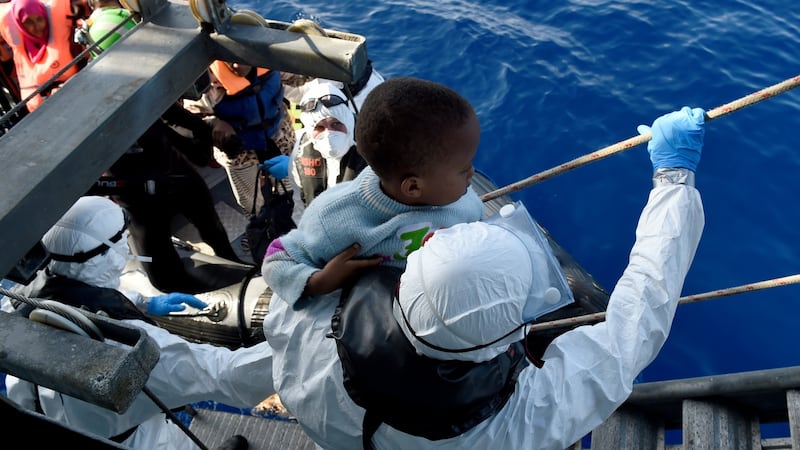Nineteen months ago, the LÉ Eithne sailed from Haulbowline naval base in Cork on the first of six humanitarian missions by the Naval Service to the Mediterranean.
The voyage would take seven days. The sailors on board, drilled and prepared, knowing it was a matter of time before they would begin to pull men, women and children from the sea.
The ramshackle migrant boats supplied by smugglers promise to spirit them to new lives. Instead, the journey guarantees not salvation, but strong odds that they might never reach land.


"More or less from day one the tempo of the work surprised us," says Capt David Barry, the service's second-in-command, looking back on the early days of the migrant crisis.
Intense missions
The Naval Service had done supply runs to Lebanon in the 1980s. It has been to the US, South America and Asia, but it had never before faced such an intense series of missions.
“We coped with it, we adapted,” he says. “We would feel that we have grown in our ability and in our confidence. Really, there is nothing that happens down there at this stage that we can’t handle.”
The numbers rescued by Ireland’s sailors are extraordinary. So far they have delivered more than 15,000 to safety. The LÉ Niamh alone rescued 4,127 between July and October last year.
By the start of December this year, almost 175,000 people had landed in Italy. Meanwhile, the numbers landing in Greece have declined, but they still reached nearly 172,000 by the end of November.
Operation Pontus
Ireland’s involvement in Operation Pontus began in May 2015 following a tragedy on April 19th, 2015, that claimed 800 lives and brought international headlines.
In turn, it led to the creation of Operation Sofia - named after a migrant child born onboard a rescue ship.In its maiden operation, the LÉ Eithne rescued 3,377 people.
In the 20 months since, Capt Barry, a 40-year veteran, has supervised operations, but now believes the high chance of being rescued is spurring the flow of migrants.
"There would be a view from within the EU force down there that the NGOs who are now operating virtually right on the 12-mile limit [demarcating international waters] of Libya act as a pull factor," he says.
“But again you are back to the conundrum: if you do nothing about it people will drown and there will be loss of life, but if you are there you are actually facilitating it,” he told The Irish Times.
The smugglers’ boats have got worse, he adds: “Once they hit the high seas they are likely to be rescued, [so] they are using, more and more, very badly constructed, literally homemade rubber inflatable boats.”
Smugglers have started to “recycle” boats, brazenly pursuing abandoned vessels after their occupants have been rescued before bringing them back to the Libyan shore to be refilled.
“Essentially these things are death traps,” Capt Barry says. Many of the craft are scuttled in time by the naval ships, but, sometimes the flow of migrants is so strong that it is impossible to sink all of them in time.
Last year the numbers were huge, but predictable. This year, things have changed: “There have been cases where the numbers are so great that we have come close to being overwhelmed,” says Barry.
‘Thousands coming’
Sometimes nothing happens for three or four days, or more: “Then suddenly you will have literally thousands coming out in one wave. That can cause stresses and strains,” he goes on.
The reasons for this are not clear. Sometimes, it’s the weather. Sometimes, it’s problems back in Libya. It could also be a deliberate tactic to push out large numbers of boats in the hope of recovering more of them.
Usually, the Naval Service are told where to look, helped by radar, aerial reconnaissance and onshore intelligence. When a boat is spotted they launch their two ribs, or high-speed dinghies.
They approach simultaneously from both sides of immigrants’ craft so the passengers will not rush to one side and possibly capsize it, which happened in the early days of the missions.
The migrants are given lifejackets and brought back to the ship where they are examined and given food and water. Later they are delivered to a “place of safety” in Italy.
The missions are distressing. So far, the Naval Service has pulled 76 bodies from the sea. Often, the rescued boats are jammed to bursting: “There seems to be a sort of pecking order,” says Barry.
‘The most dangerous place’
“If you are able to buy a place on the deck, you buy a place on the deck. If you can’t, you buy a place below deck - and that’s the most dangerous place,” Capt Barry explains.
The conditions on the larger boats are dreadful, but they are more seaworthy than ones now being used. “One young man.. came aboard. The only possessions he had were a mobile phone and a football.”
Most of the migrants are men. So far, the LÉ Samuel Beckett has rescued 2,584 men, 454 women and 64 children.
Even amid the darkness of such operations, however, there can be lighter moments.
During one operation, a GAA-loving naval rating from Cork helped a West African migrant who was wearing a Clare jersey: “He had no idea what he was wearing,” recalls Capt Barry.
Despite being professionals and having been highly trained, the welfare of the Irish crews is prioritised. Counsellors can be brought onboard to help them - urgently if is judged to be necessary.
“It’s relatively easy to see if somebody is struggling,” says Capt Barry. “[But] it’s very rewarding work. People come back and they want to go back down again. We have no problems getting people to go.”












